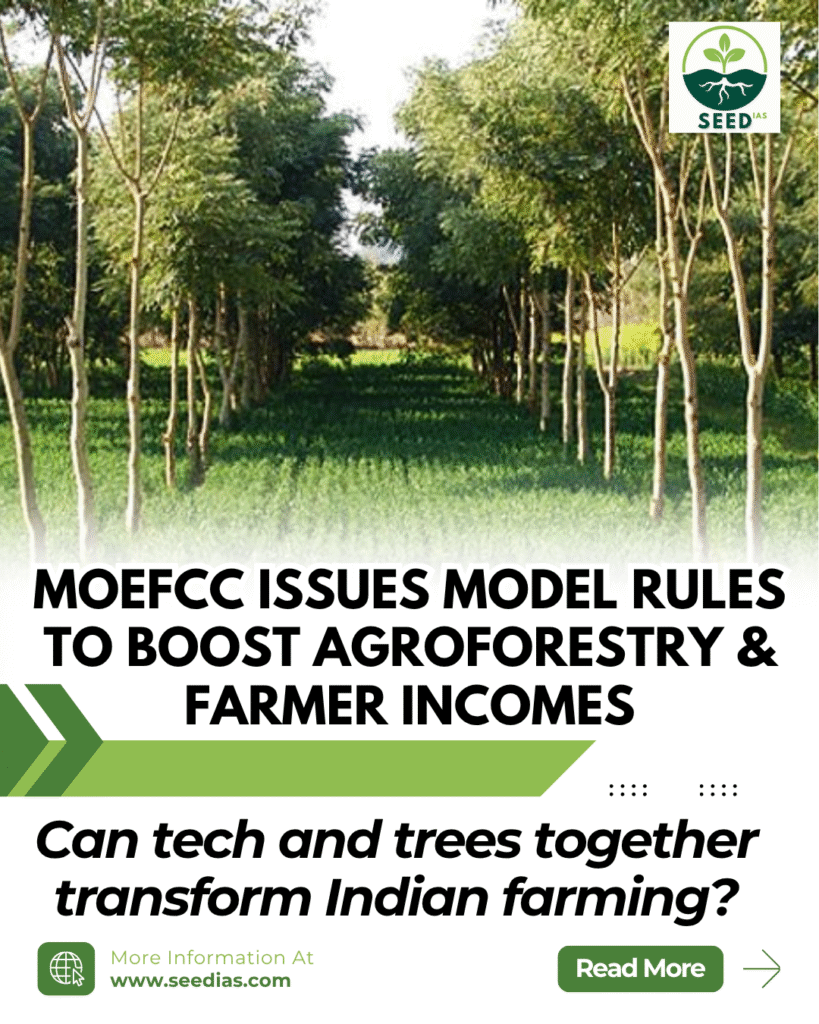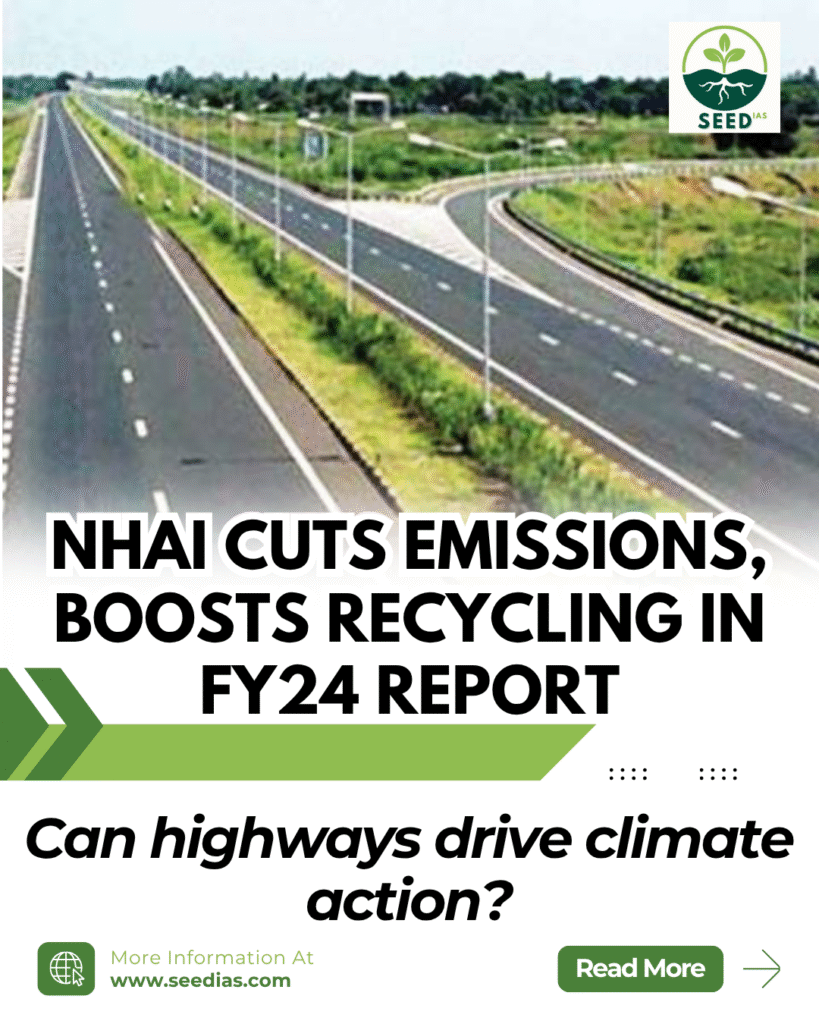Why in NEWS
The Ministry of Environment, Forest and Climate Change (MoEFCC) released Model Rules for Felling of Trees on Agricultural Lands to simplify permissions, encourage agroforestry, support farmers, and reduce pressure on forests.
It promotes digital monitoring through remote sensing and supports India’s global commitments under UNFCCC, CBD, and SDGs 2, 13, and 15.
What are the Key Highlights of Model Rules by MoEFCC for Promoting Agroforestry?
| Feature | Description |
|---|---|
| Simplified Regulations | Uniform procedure for registration, felling, and transit of trees on farms; overrides inconsistent state-level rules. |
| NTMS Portal | Central National Timber Management System lets farmers apply online with geo-tagged data, KML files, and photos. |
| Felling Classification | <10 trees: Self-declared via portal; >10 trees: Verified by certified agencies. |
| Institutional Framework | State Level Committee (SLC) under 2016 guidelines; DFOs oversee implementation. |
| Tech-based Oversight | Real-time digital tracking using image recognition and remote sensing. |
| Market Integration | Reduces timber imports by promoting local high-value species like teak, eucalyptus, and poplar. |
What is Agroforestry?
| Aspect | Details |
|---|---|
| Definition | Integration of trees with crops and/or livestock on the same land for economic and ecological benefits. |
| Area Coverage in India | 28.4 million hectares (~8.65% of total land). |
| Policy Support | National Agroforestry Policy launched in 2014. |
| Components | Fruit/fuel/fodder/timber trees on farms, tree-crop models (e.g., coffee, cocoa), forest-edge farming. |
Types of Agroforestry
| Type | Explanation |
|---|---|
| Farm Forestry | Tree cultivation by farmers for income; promoted by NCA (1976). |
| Extension Forestry | Greening degraded and non-forested areas. |
| Mixed Forestry | Combines fruit, fodder, and fuel trees on village lands. |
| Shelterbelts | Tree rows protecting farms from wind, erosion, heat. |
| Linear Plantations | Trees planted along roads, canals, railways. |
Key Benefits of Agroforestry
| Type | Benefits |
|---|---|
| Economic | Meets ~50% of fuelwood, 66% of small timber, 60% of pulp needs. Enhances income via multiple products—fruits, fibre, fuel, etc. |
| Environmental | Can sequester 2.5 billion tonnes of CO₂ by 2030. Improves soil fertility, supports biodiversity, reduces agrochemical use. |
| Climate Resilience | Enhances ecosystem stability, water retention, pest control. |
| Global Commitments | Supports India’s Net-Zero (2070), Paris Agreement goals, and SDGs (9 out of 17). |
| Renewable Energy | Biomass from agroforestry contributes to clean energy generation. |
Key Government Initiatives on Agroforestry
| Initiative | Description |
|---|---|
| National Agroforestry Policy (2014) | First such policy globally; promotes convergence, simplified norms, and R&D. |
| Sub-Mission on Agroforestry (SMAF), 2016 | Incentivizes tree planting on farms, especially for small farmers, under NMSA. |
| All India Coordinated Research Project (AICRP), 1983 | ICAR initiative for region-specific agroforestry models. |
| GROW by NITI Aayog | Aims to restore 26 million ha degraded land using remote sensing and ASI via Bhuvan Portal. |
Key Challenges in Effective Utilization of Agroforestry Policy
| Challenge | Description |
|---|---|
| Regulatory Fragmentation | Different tree felling rules across states; poor inter-departmental coordination. |
| Low Awareness | Farmers unaware of agroforestry benefits and best practices. |
| Financial Barriers | Long gestation, no insurance, weak market linkages deter adoption. |
| Digital Divide | NTMS underused due to low rural connectivity and literacy. |
| R&D Gaps | Lack of climate-smart species models and risk perceptions slow uptake. |
What Measures Should be Taken for Effective Implementation?
| Measure | Action Required |
|---|---|
| Regulatory Reform | Uniform tree felling rules and active State Level Committees. |
| Farmer Awareness | Local training via KVKs, ICAR, forest depts. on climate-smart models. |
| Financial Tools | Agroforestry-specific loans, insurance, and PPP models. |
| Digital Infrastructure | Expand NTMS use with GIS, AI, remote sensing for tracking and compliance. |
| Research & Demonstration | Establish pilot farms, improve species diversification, and de-risk adoption. |
Conclusion
MoEFCC’s Model Rules mark a pivotal shift toward climate-smart agriculture through agroforestry. Realizing their potential requires bridging gaps in regulation, awareness, finance, and monitoring. A robust agroforestry system can simultaneously empower farmers, restore degraded land, and help India meet its climate and sustainability goals.
In a Nutshell – Use Code “AGROFIT”
A – Agroforestry for income & ecology
G – GROW initiative for degraded lands
R – Rules simplified via NTMS portal
O – Overcoming regulatory fragmentation
F – Fuel, fibre, fodder, fruit, fertiliser
I – Institutional coordination needed
T – Tree-based carbon sink for Net-Zero
Prelims Practice Questions
- Which of the following is a feature of the NTMS portal under the Model Rules?
A) Offline application for tree cutting
B) Confined to forest lands only
C) Uses geo-tagged photos and KML files
D) Allows sale of imported timber only - What is the purpose of shelterbelt plantations in agroforestry?
A) Soil fertility improvement
B) Pest control
C) Wind protection and erosion prevention
D) Carbon trading - GROW initiative by NITI Aayog primarily focuses on:
A) Growing rice in semi-arid areas
B) Developing new GM crops
C) Agroforestry for degraded land restoration
D) Monitoring urban tree cover
Mains Practice Questions
- Examine the potential of agroforestry in addressing climate change, enhancing farmer income, and achieving India’s SDG targets. (GS3 – Environment & Agriculture)
- Discuss the role and significance of MoEFCC’s Model Rules on tree felling in promoting sustainable agroforestry. What are the key hurdles in their implementation? (GS – 3)
Answer Key – Prelims
| Qn | Answer | Explanation |
|---|---|---|
| 1 | C | NTMS uses geo-tagged data and KML for digital monitoring. |
| 2 | C | Shelterbelts protect against wind and reduce soil erosion. |
| 3 | C | GROW focuses on restoring degraded land through agroforestry. |
















